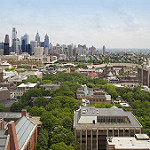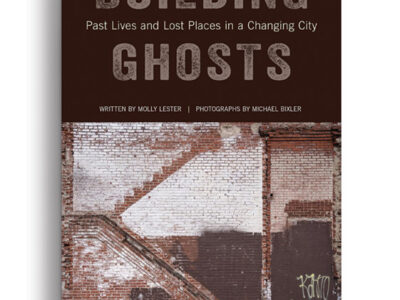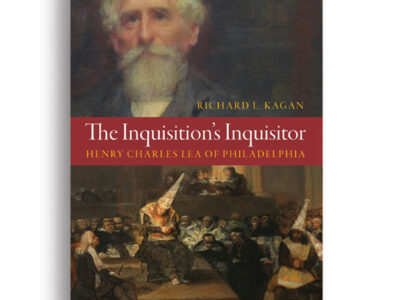
A treasure trove of Philadelphia Orchestra documents finds a home at Penn Libraries.
For the last two decades, the Philadelphia Orchestra has said “thanks, but no thanks” to researchers interested in rummaging through its massive trove of financial records and organizational bylaws, personnel andpersonal letters, and countless photographs and slides. Now, thanks to an agreement announced at the end of last year between the 123-year-old Orchestra and the Penn Libraries, that’s about to change.
The Orchestra’s archives—consisting of about 1,000 boxes of documents pertaining to the orchestra and its longtime venue, the historic Academy of Music—are now part of Penn’s Kislak Center for Special Collections, Rare Books and Manuscripts.
The gift represents a pitch-perfect match, according to Kislak director Sean Quimby. “Music associated with our city has been a particular curatorial focus and expertise of ours for a while now,” he says. “We’ve covered music in and around Philadelphia from its founding, with the collection of Francis Hopkinson [a signer of the Declaration of Independence, as well as a composer] through the long history of the Philadelphia Musical Fund Society [founded in 1820 to support musicians and still going] and into the 20th century.”
In addition to housing collections that include the Robert and Molly Freedman Jewish Sound Archive [“Profiles,” May|Jun 2018] and that of the Philadelphia singer and civil rights activist Marian Anderson Hon’58 [“Gazetteer,” Sep|Oct 2020], the Kislak Center is also the custodian of the papers of Leopold Stokowski and Eugene Ormandy, the legendary conductors who, respectively, pushed the “Fabulous Philadelphians” into modernity and then steered it into its position among the world’s best musical assemblages.

Matias Tarnopolsky, the president and CEO of the Philadelphia Orchestra, first toured the archives at the Academy of Music when he joined the organization in 2018. Reviewing items like the Orchestra’s founding documents or a handwritten 1912–13 season grid prepared by Stokowski renewed his appreciation for the “innovation that has defined this Orchestra since its inception,” Tarnopolsky says. “Having a firsthand and deeper understanding of our past is profoundly inspiring and can help to shape and inspire our future. But I was also concerned that they were tucked away and inaccessible. Making these stories available and accessible became an immediate priority.”
Although most of the archival materials have shifted to Penn Libraries, the Orchestra will hang onto a few key aspects of the holdings, including an extensive collection of current and historical scores that are used to this day for performances.
The collection includes both the “profound and the mundane,” says Quimby. “In a lot of the documents, we’re privy to the huge amount of invisible labor that goes into making a production happen and managing these brilliant personalities who are the face of the Orchestra.” But whether it’s a letter from composer Sergei Rachmaninoff to Ormandy, or a detailed itinerary for a 1937 monthlong coast-to-coast train tour—complete with Pullman car assignments—the material is compelling.
Other highlights include performance programs spanning a century, a 178-box cache of records relating to the design and history of the Academy of Music, and nearly 50 boxes containing photos, including many autographed by notable artists and conductors. Separately, there are another 75 boxes containing 300,000 images (in formats such as black-and-white prints, negatives, contact sheets, and proofs) made by Adrian Siegel, a longtime Orchestra cellist (1922–1959) who morphed from the institution’s unofficial to (upon his retirement) official photographer, exhaustively documenting rehearsals and candid moments between peers.
Although mostly comprised of paper, the archives do contain some other media. Scattered among the photos are varied batches of slides, including some taken by various Orchestra members while on global tours. The recording collection of Donald Wetzel, an audio engineer for the Orchestra’s radio broadcasts during the ’60s and ’70s, includes a complete set of the group’s original 78rpm recordings (starting with its very first one from 1917), along with hundreds of other LPs, reel-to-reel tapes, cassettes, and CDs. Additionally, the donation includes more than 40 boxes of original film and video footage from programs produced by or for the Orchestra, as well as copies of broadcast TV specials, news appearances, and promos and ads. Another collection consists of dozens of tapes from an oral history project.
As an historian of technology, Quimby is especially intrigued by the chance to explore the impact of these changing media environments. “They allow us to trace the emergence of the Orchestra as a globally significant organization that adeptly adjusted to media formats as they developed,” he says. Another research thread that the trove might help unravel, he suggests, is the history of what were then known as women’s volunteer committees. The Orchestra’s version— formed in 1904, four years after its first concerts—was the first permanent organization of this kind in the US.
For now, though, the emphasis will be on getting the material in shape, little by little, for public access. “The archives arrived to us in pretty good condition since the Orchestra had a staff archivist,” Quimby says. “But there’s a difference between having a box that says it contains 1,000 pages of correspondence, and the kind of granular detail that will really help fine-tune the ability to research very specific topics.” He estimates that it will take between three and five years to wrestle the material into order. The goal is to post material online as the work on cataloging and conservation is completed.
Performances and exhibitions will be part of the mix, too. This spring, for example, marks the return of the pandemic-interrupted “Music in the Pavilion Series” in the 1978 Orrery Pavilion on the sixth floor of Van Pelt Library. “We’re very excited about the possibilities of sharing this extraordinary and special new addition to Kislak in as many ways as possible,” Quimby says.
—JoAnn Greco




